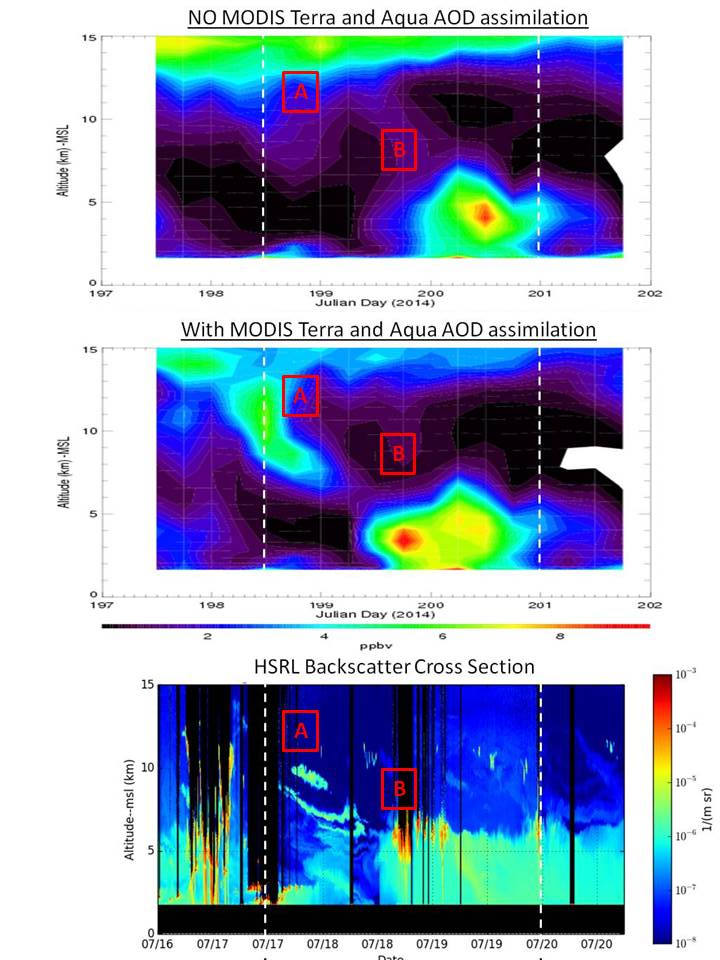
[ Archive ]

 |
ASPB and CIMSS Weekly Report
[ Archive ] |
 |
IN THE PRESS:
ITEMS FOR THE ADMINISTRATOR:
ITEMS FOR THE ASSISTANT ADMINISTRATOR:
ITEMS FOR THE OFFICE DIRECTOR, STAR:
Review Paper on Arctic Sea Ice Published: A review paper on recent changes in Arctic sea ice and their impacts has been published in Reviews of Geophysics (Meier, W., G. Hovelsrud. B. van Oort, J. Key, K. Kovacs, C. Michel, C. Haas, M. Granskog, S. Gerland, D. Perovich, A. Makshtas, and J. Reist, 2014, Arctic sea ice in transformation: A review of recent observed changes and impacts on biology and human activity, Rev. Geophys., 51, doi: 10.1002/2013RG000431). The paper is an update of the material published in the 2011 Arctic Monitoring and Assessment Programme's (AMAP) "Snow, Water, Ice, and Permafrost of the Arctic" report. The paper is available at http://onlinelibrary.wiley.com/doi/10.1002/2013RG000431/abstract. (J. Key, E/RA2, 608-263-2605, jkey@ssec.wisc.edu)
Paper Published on the evaluation of a high-resolution model through comparison with MODIS observations: The brightness temperatures (BT) converted from a Weather Research and Forecasting (WRF)model simulation were compared to Moderate Resolution Imaging Spectroradiometer (MODIS) measurements. Interestingly, the MODIS cloud optical thickness tend to be too large for thin cirrus clouds, which contributed to the apparent cold BT bias in the simulated thin cirrus clouds. The citation is Lee, Y.-K., T. Greenwald, and J. A. Otkin, 2014, “Evaluation of the accuracy of a high-resolution model simulation through comparison with MODIS observations”, J. Appl. Meteorol. Clim., 53, 1046-1058. (Yong-Keun Lee, CIMSS)
Manuscript on Retrieval of Quadratically Coupled Wave Modes from Sunglint Data Published: A manuscript entitled “Retrieval of Higher Order Ocean Spectral Information From Sunglint” was published as an early access article in the journal IEEE Transactions on Geoscience and Remote Sensing (doi:10.1109/TGRS.2014.2317477). An approach was developed to retrieve the ocean slope bispectrum, which describes the nonlinearity of the slope surface, from ocean sunglint data. By extending a Gaussian slope probability density using a perturbative approach, a series of relationships between the slope and glint cumulants and cumulant functions up to third order were derived. These relationships were inverted to retrieve the slope third cumulant function, from which we obtained the slope bispectrum via Fourier transformation. The retrieval method was validated using synthetic 1-D ocean wave slope datasets with controlled phase correlations imposed on a subset of the wave spectrum components. The author is Geoff Cureton (Cooperative Institute for Meteorological Satellite Studies, CIMSS). (Geoff Cureton, geoff.cureton@ssec.wisc.edu, 608-890-0706)
FRAPPE/DISCOVER-AQ Field Mission: Brad Pierce participated in the joint Colorado Department of Public Health and Environment (CDPHE), National Science Foundation (NSF) Front Range Air Pollution and Photochemistry Experiment (FRAPPE) and NASA Deriving Information on Surface conditions from Column and Vertically Resolved Observations Relevant to Air Quality (DISCOVER-AQ) field mission based out of Broomfield, CO. During the deployment he provided Real-time Air Quality Modeling System (RAQMS) air quality forecasts for flight planning, helped coordinate Geostationary Trace gas and Aerosol Sensor Optimization (GeoTASO) flights, and collaborated with the Space Science and Engineering Center (SSEC) in deployment of ground based Atmospheric Emitted Radiance Interferometer (AERI) and High Spectral Resolution Lidar (HSRL) for atmospheric temperature, water vapor, trace gas, and aerosol retrievals for GOES-R and JPSS validation. Two parallel RAQMS forecasts are being conducted during July-August, 2014 to evaluate the impact of assimilation of aerosol optical depth (AOD) retrievals from the Moderate Resolution Imaging Spectroradiometer (MODIS) onboard the NASA Terra and Aqua satellites. Comparisons between RAQMS black and organic aerosol (BCOC) wildfire smoke predictions and aerosol backscatter measurements from the University of Wisconsin High Spectral Resolution Lidar (HSRL) at the NOAA Boulder Atmospheric Observatory (BAO) outside of Erie, CO show that assimilation of MODIS AOD improves the prediction of upper level smoke from Canadian [A] and boundary layer smoke from Pacific Northwest [B] wildfires observed during FRAPPE/DISCOVER-AQ. These results are being used to support NOAA Joint Polar Satellite System (JPSS) and GOES-R Fire and Smoke Proving Ground Initiative (PGI) activities (R.B. Pierce, E/RA2, 608-890-1892, brad.pierce@noaa.gov)
 (Click image to enlarge)
(Click image to enlarge)
Figure caption: Real-time Air Quality Modeling System (RAQMS) Black and Organic Carbon (BCOC) aerosol (ppbv) without (upper panel) and with (middle panel) MODIS Aerosol Optical Depth (AOD) assimilation compared to UW-Madison High Spectral Resolution Lidar (HSRL) backscatter cross section (lower panel) at the NOAA Boulder Atmospheric Observatory (BAO) Tower from 12Z July 16 – 18Z July 20, 2014.
ITEMS FOR THE DIVISION CHIEF, CoRP:
MS Thesis Presentation on Clouds Over Greenland: Kyle Nelson, a graduate student in the Department of Atmosphere and Oceanic Sciences supported on a Cooperative Institute for Meteorological Satellite Studies (CIMSS) project, presented his Master's thesis work on August 6, 2014. The thesis, titled "The Role of Optically Thin Liquid Clouds in the 2012 Greenland Ice Sheet Surface Melt Event", presents his research on the radiative effect of clouds on the surface and how a particular cloud type contributed to an historical surface melt event in July of 2012. The work employed a variety of satellite sensors and demonstrated the difficulties in using current products in the study of Arctic clouds. (K. Nelson, CIMSS; J. Key, E/RA2, 608-263-2605, jkey@ssec.wisc.edu; S. Ackerman, CIMSS, 608-263-3647)
Gerth Assists CPHC Ahead of Tropical Cyclones: Jordan Gerth, a research associate with the Cooperative Institute for Meteorological Satellite Studies (CIMSS), provided assistance to the National Weather Service (NWS) Central Pacific Hurricane Center (CPHC) in Honolulu, Hawaii, in answering media questions and conducting live radio and television interviews related to Hurricane Iselle and Hurricane Julio between 4 August and 7 August 2014. Gerth was on travel to Honolulu, Hawaii, to assist with NOAA satellite proving ground activities. However, the CPHC was short staff due to a number of personnel on travel and vacation. CPHC issued the first hurricane warning for a portion of Hawaii since 1993. (J. Gerth, CIMSS, 608-263-4942)
VISITORS:
NEXT WEEK:
LOOKING AHEAD:
| Archived Weeklies Page | Submit a report item |